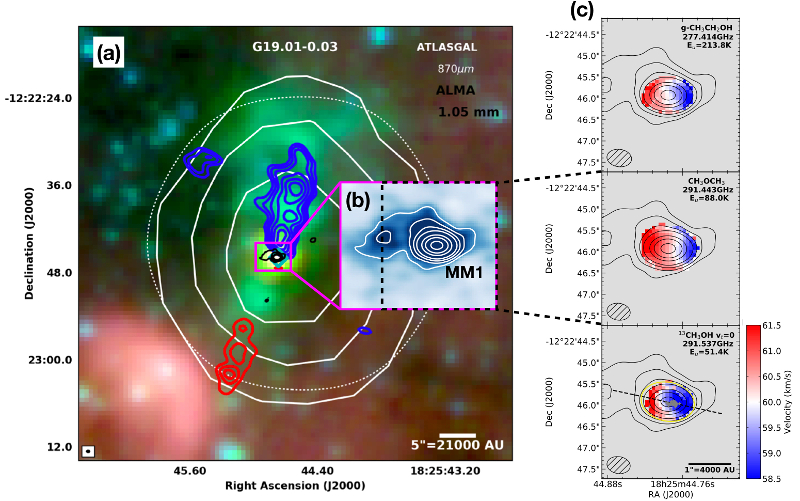| EPoS Contribution |
|
ALMA gas dynamics reveal new Keplerian circumstellar disc candidate around MYSO
Gwenllian Williams Herts, Hatfield, UK | |
|
High-mass stars are a key constituent of galaxies, yet much remains unknown about the gathering of their mass. Models suggest that high-mass stars must accrete material through rotating circumstellar discs similarly to low-mass stars, however only a few Keplerian discs have been observed around O-type (proto)stars to date. The massive young stellar object (MYSO) G19.01-0.03 MM1 is an Extended Green Object (EGO) that appears, in 2.4arcsec angular resolution SMA observations, as a single millimetre core driving a well-collimated bipolar molecular outflow. This source thus represents a good candidate for high resolution, high sensitivity observations to use the insight provided by gas dynamics in the search for elusive high-mass disc-outflow systems. Here, we present ALMA Band 7 observations of MM1 with 0.4arcsec~1600AU angular resolution, which are 16 times more sensitive and 6 times better in angular resolution compared to our previously published SMA data. The most striking result of the ALMA observations is the first evidence of a Keplerian disc around MM1, perpendicular to the bipolar outflow direction. A moment analysis shows that the velocity gradient across the disc is consistently traced with a wide range of molecular species, and position-velocity models reveal the disc to have an enclosed mass of 50Msun within an outer radius of 2300AU. The bolometric luminosity of MM1 at 104L | |
 | |
| Caption: (a) Spitzer GLIMPSE three colour image of G19.01-0.03 MM1 (RGB: 8.0, 4.5, 3.6 micron). High velocity SMA 12CO(2-1) emission are plotted in blue (at 7.2, 9.6, 12.0, 15.6, 19.2, 22.8 Jy/beam km/s) and red (at 4.8, 7.2, 9.6 Jy/beam km/s) contours. ATLASGAL 870micron emission is plotted in solid white contours, whilst the dotted white line shows the 30% power point of the ALMA mosaic. (b) ALMA 1.05mm dust continuum image of MM1, with overlaid contours in white (at 2, 4, 8, 16, 50, 100, 200 mJy/beam). (c) Example moment one maps towards MM1 from three different molecular species (g-CH3CH2OH, CH3OCH3 and 13CH3OH). Maps are masked to 5σ, black contours are the same as those plotted in panel (b), and the dashed black line shows the line perpendicular to the bipolar outflow direction. Grey crosses in the bottom panel mark the positions of 6.7GHz Class II methanol masers. | |
| Collaborators: C.J. Cyganowski, U St Andrews, UK P. Nazari, UoC, UK C.L. Brogan, NRAO, US T.R. Hunter, NRAO, US J.D. Ilee, UoL, UK I. A. Bonnell, U St Andrews, UK J.M.D. Kruijssen, ARI/ZAUH, DE R.J. Smith, UoM, UK |
Suggested Session:
High-Mass Star Formation |

